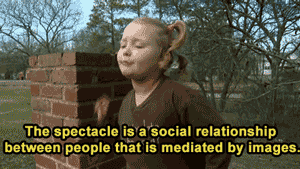We spent this week mostly *listening*, from Count Basie to Public Enemy and many stops in between as we considered the creative cultural commons of music over the decades, and the relationship between the evolutioin of recording technology and of copyright protection. Some examples we listened to and discussed were:
-the infamous plaigarism case between George Harrison (My Sweet Lord 1971) and Bright Tunes Corporation (He's So Fine, recorded by The Chiffons 1962)
-Douglas Kahn's 1980 tape collage of Ronald Reagan and Bill Moyers, distributed via flexi-disc in Raw Magazine, Reagan Speaks for Himself
-Afrika Bambatta's breakthrough track Planet Rock (1982), and the relationship of his sampling to his collecting, see Bambatta's amazing archive of records , just recently sent to the Cornell University Hip Hop Colleciton for posterity.
-DAvid Byrne and Brian Eno's My Life in the Bush of Ghosts (1981) and Bruce Conners film made for one of those tracks America is Waiting (1982)
We also talked about the 2004 project Jay-Z's Construction set which is a huge zip file full of everything you need to remix his album, in the hopes that it will inspire new artists to add their voices to the cacophony. "Make as much music as possible" he says. A DJ named Dangermouse did just that, when he released The Grey Album which combined Jay Z's vocals from The Black Album with instrumentals from The Beatles White Album. A lawsuit ensued and music and free culture lovers protested by picking one day to post The Grey Album for anyone to download--this day will forever be known as GREY TUESDAY .
Lastly we watched the entire film of COPYRIGHT CRIMINALS, shown on PBS Independent Lens and produced by Kembrew McLeod, who also organized a collage practice conference and edited a book of those participants called Cutting Across Media: Appropriation Art, Interventionist collage, and Copyright Law. The first chapter is by Marcus Boon and is called Digital Mana: On the Source of the Infinite Proliferation of Mutant Copies in Contemporary Culture.
Et voila!
























